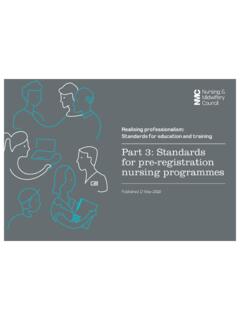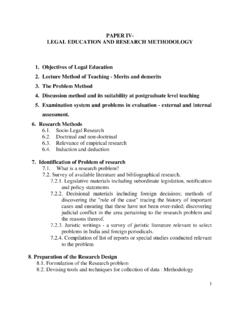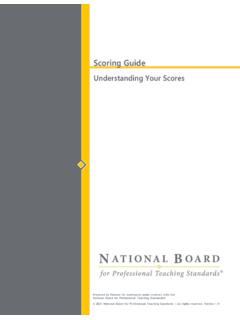Transcription of MDCG 2022-3 Verification of manufactured class D IVDs by ...
1 Medical Devices Medical Device Coordination Group Document MDCG 2022-3 Page 1 of 11 MDCG 2022-3 Verification of manufactured class D IVDs by notified bodies February 2022 This document has been endorsed by the Medical Device Coordination Group (MDCG) established by Article 103 of Regulation (EU) 2017/745. The MDCG is composed of representatives of all Member States and it is chaired by a representative of the European Commission. The document is not a European Commission document and it cannot be regarded as reflecting the official position of the European Commission. Any views expressed in this document are not legally binding and only the Court of Justice of the European Union can give binding interpretations of Union law. Medical Devices Medical Device Coordination Group Document MDCG 2022-3 Page 2 of 11 1. Introduction Regulation (EU) 2017/746 on in vitro diagnostic medical devices (IVDR) establishes the requirements for notified bodies involved in the conformity assessment of applicable classes of in vitro diagnostic medical devices (IVDs).
2 Manufacturers must demonstrate that the devices conform to relevant requirements based upon objective evidence and analysis. In accordance with these conformity assessment procedures1, in addition to quality management system and technical documentation assessments, notified bodies are required to verify product batches of class D IVDs in line with Annexes IX and XI of the IVDR. Therefore, in order to verify the conformity of class D IVDs, manufacturers should forward to notified bodies the reports on tests carried out on each manufactured batch of class D devices2. Furthermore, the manufacturer should make available samples of manufactured class D devices or batches of devices to the notified body in accordance with pre-agreed conditions and detailed arrangements. The notified body involved in the conformity assessment of class D IVDs should request one of the EU reference laboratories (EURLs), if designated by the European Commission3, to carry out batch testing on those devices.
3 The EURL should, in turn, inform the notified body about its findings. Following this Verification procedure, manufacturers may place class D IVDs on the market unless the notified body communicates to the manufacturer within an agreed timeframe, but not later than 30 days after reception of the samples, any other decision4. In the absence of a designated EURL for a device, the requirements relating to EURLs do not have to be applied. 2. Scope This document aims to provide guidance to notified bodies to clarify their role and responsibilities in relation to samples of manufactured class D devices or batches of devices in accordance with Annexes IX and XI of the IVDR. This guidance also describes best practices for notified bodies in performing conformity assessment procedures relating to the Verification of manufactured class D IVDs. It also includes guidance on: relevant information to be included within the notified body's procedures, the content of the required pre-agreed conditions and detailed arrangements5 between the notified body and the manufacturer, 1 IVDR Article 48 2 IVDR Annex IX section & Annex XI section 3 IVDR Article 100 4 IVDR Annex IX section & Annex XI section 5 IVDR Annex IX Section & Annex XI Section Medical Devices Medical Device Coordination Group Document MDCG 2022-3 Page 3 of 11 guidance on the frequency of samples of devices or batches of devices to be sent to the EURL6.
4 3. Definitions class D IVDs The IVDR refers to class D devices in rules 1 and 2 of Annex VIII as follows: Devices intended to be used for the following purposes are classified as class D: - detection of the presence of, or exposure to, a transmissible agent in blood, blood components, cells, tissues or organs, or in any of their derivatives, in order to assess their suitability for transfusion, transplantation or cell administration; - detection of the presence of, or exposure to, a transmissible agent that causes a life-threatening disease with a high or suspected high risk of propagation; - determining the infectious load of a life-threatening disease where monitoring is critical in the process of patient management. [IVDR, Article 47(I) & Annex VIII Section 2 Rule 1] Devices intended to be used for blood grouping, or to determine foeto-maternal blood group incompatibility, or for tissue typing to ensure the immunological compatibility of blood, blood components, cells, tissue or organs that are intended for transfusion or transplantation or cell administration, are classified as class C, except when intended to determine any of the following markers: - ABO system [A (ABO1), B (ABO2), AB (ABO3)]; - Rhesus system [RH1 (D), RHW1, RH2 (C), RH3 (E), RH4 (c), RH5 (e)]; - Kell system [Kel1 (K)]; - Kidd system [JK1 (Jka), JK2 (Jkb)]; - Duffy system [FY1 (Fya), FY2 (Fyb)] [IVDR, Annex VIII Section 2 Rule 2] Note: Please see MDCG 2020-167 (Guidance on Classification rules for in vitro Diagnostic Medical Devices under Regulation (EU) 2017/746) for examples of devices falling in class D.
5 Batch A defined amount of material, either starting material, intermediate or finished product which is uniform in its properties and has been produced in one process or series of processes. [EN 13975:2003] 6 IVDR Annex IX Section & Annex XI Section 7 Medical Devices Medical Device Coordination Group Document MDCG 2022-3 Page 4 of 11 Common specifications A set of technical and/or clinical requirements, other than a standard, that provides a means of complying with the legal obligations applicable to a device, process or system. [IVDR Article 2 (74)] EU Reference Laboratory (EURL) A European Union reference laboratory designated according to Article 100 of the IVDR. Verification Confirmation, through the provision of objective evidence, that specified requirements have been fulfilled. [EN ISO 9000:2015] Sample One or more units of product, either components or finished devices, drawn from a batch without regard to the quality of the units [EN 13975:2003] Specimen Small portion of a body fluid or tissue taken from an individual for examination, study or analysis of one or more quantities or characteristics to determine the character of the whole.
6 4. Notified Body Procedures The notified body should have documented procedures for8: - The Verification process - The establishment of a test plan identifying all relevant and critical parameters which need to be tested for the device, including decision making criteria for success or failure of the batch - The provision for the reaching of an agreement with the manufacturer concerning when and where the necessary sample or batch testing has to be performed An agreement on the batch Verification arrangements should be in place between the notified body and the manufacturer of the class D IVD. In addition, provided that a EURL is designated for this device, the notified body should also make arrangements with the EURL for the testing of the device. 8 IVDR Annex VII Medical Devices Medical Device Coordination Group Document MDCG 2022-3 Page 5 of 11 The notified body should draw up a testing plan for the device to be provided to the EURL (see also section below).
7 This plan should be based upon the results of the notified body's conformity assessment, the performance Verification opinion of an EURL9, as well as, any other relevant information from the manufacturer and the EURL. The EURL may propose justified changes based on its scientific expertise. The testing plan is then agreed between the notified body and the EURL. It should be included in the agreement between the notified body and the manufacturer, and in the written contract between the notified body and the EURL. It should be noted that EURLs are independent scientific and testing bodies designated by the Commission for the purposes defined in IVDR. Therefore, EURLs should not be considered as subcontractors to notified bodies in the same sense as other testing laboratories. Pre-Agreed Conditions and Detailed Arrangements The performance of a class D IVD will usually have already been verified by a EURL for that device10.
8 The Verification of manufactured batches will typically be arranged with the same EURL. Nevertheless, a different EURL designated with the applicable scope and equipment may be chosen. In the case of several EURLs available for a certain device, the notified body should decide (following consultation with the manufacturer) which EURL is most appropriate to perform the batch Verification . Factors to be considered include, for example, the product range of the manufacturer (due to other class D devices to be tested), sample logistics as well as language or other issues which may affect the choice of EURL. Agreement between the notified body and the manufacturer The agreement between the notified body and the manufacturer should include at least the following: - Test plan, as approved by the EURL o Relevant and critical parameters to be tested o Decision making criteria for success or failure of the batch o Samples to be tested o Specimens to be tested o Other specific materials provided by the manufacturer o Testing frequency o Test platform and protocol used o Reference to any applicable common specifications and relevant standards or other solutions chosen by the manufacturer11 o Reference to the designation scope of the EURL - The logistics of the provision of samples and other materials ( calibrators and controls) or equipment from the manufacturer to either the notified body 9 IVDR Articles & 100 2(a) 10 IVDR Articles & (a) 11 IVDR Article 100 2(a)
9 Medical Devices Medical Device Coordination Group Document MDCG 2022-3 Page 6 of 11 and/or the EURL, including the need for any special storage and transport arrangements - Special arrangements in the case of devices or specimens with exceptionally short shelf-lives or the need for special equipment. - Provision of batch release quality control (QC) results from the manufacturer to the notified body - Details of the information to be provided by the manufacturer to the notified body and to the EURL with each batch - Commitment of the manufacturer to inform the notified body if the manufacturer is to send to the samples directly to the EURL - Commitment of the manufacturer to immediately inform the notified body of any changes that may have an effect on the Verification of manufactured batches. This may include changes to manufacturing, raw materials (ingredients, formulation etc), equipment, quality control, transport or storage - Commitment of the manufacturer to inform the notified body and the EURL of any relevant scientific, technical or clinical information which has come to its knowledge, which may have an impact on the scientific or technical validity of the batch Verification testing scheme.
10 This could include, for example, information on emergence of a new variant strain for microbiological assays, or knowledge of new interfering or cross-reacting substances - Agreement of the manufacturer for the notified body to provide any relevant information to the EURL - Provision of the results and conclusions of the Verification of manufactured batches from the notified body to the manufacturer, including an agreed timeframe (not more than 30 days after reception of the samples) - Financial conditions, costs for material storage and logistics - Contact information for communication between the notified body and the manufacturer The manufacturer may be actively engaged in the selection of the EURL that will perform the batch testing. Written contract between the notified body and the EURL The written contract between the notified body and the EURL should include at least the following.












